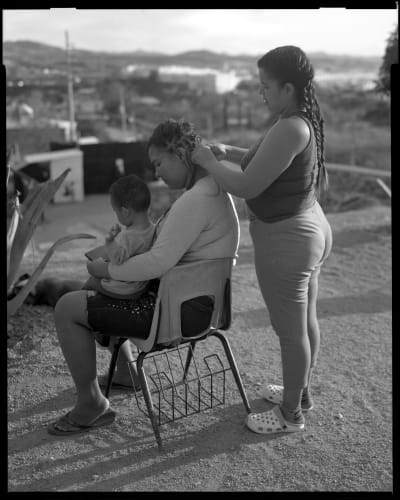Douglas Miles, multimedia artist, curator and founder of Apache Skateboards, has a long tradition of centering and asserting Apache people into the world as important and prominent individuals, each worthy of filling up space and artistic consideration. Whether the work is showcased at home on the San Carlos Apache Reservation, a mural on a busy city street or in a gallery space, Miles multifaceted approach to art is rooted in his relationships. His work represents a significant and meaningful opportunity for Apache and other Native people to see themselves reflected sincerely, in a way that seldom happens in spaces dominated by settler colonial narratives.
His photographic sculptures, featuring the images of both important historical Apache figures and members of his own family and immediate circle, evoke through his use of vintage suitcases and gas cans, the things that we carry with us, our connections to people and place. Mile’s work accents the full dimensionality of his subjects both as individuals and as part of a whole, in the larger Apache and Native community, spanning both forwards and backwards in time.
When viewing Mile’s work there is an inescapable recognition of generationality. Native faces, young and old, gaze back at the audience. Today these audiences frequently consist of folks of all backgrounds, of both Indigenous and settler colonial heritage, but through his work, Miles directly addresses the multitudes of Apache folks that came before him, and will follow after, while still providing opportunity for non-native peoples to engage with his perspective. Mile’s work is assertive and earnest while remaining rich with a sense of love and respect. Always rooted in his position as a Rez based artist, he melds traditional and archival photography with his illustrative practice, centering his legacy and experience and that of the cherished people surrounding him - friends, family and kin.
- words by artist Marcus Xavier Chormicle
Lisa Elmaleh’s Tierra Prometida is more urgent than ever. While mainstream media often sensationalizes migration, reducing people to fleeting images of suffering, Lisa’s work offers a necessary counternarrative—one that restores depth, dignity, and nuance.
Consider Maichol (2023), whose portrait is featured in this exhibition. His family fled political persecution in Venezuela in 2023 and endured the treacherous crossing of the Darién Gap. Or Marisela (2022), who escaped Guerrero, Mexico, with her three children after being extorted by cartels. Their stories are deeply personal, yet they reflect a larger collective reality. In 2023, seven million people left Venezuela, and over 700,000 fled Mexico. But statistics alone fail to capture the human cost of displacement. Instead, they are often used to flatten experiences, turning real people into numbers that fuel anti-immigrant rhetoric and policies—like renewed calls to expand the border wall.
Lisa began this project during the first Trump administration, seeking to cut through political noise and understand migration beyond partisan rhetoric. Like many who engage with border work, she has come to see that xenophobia and anti-immigrant policies transcend party lines. Her photograph Border Patrol dragging tires to search for footprints, West Texas, United States (2020), she examines Prevention Through Deterrence, a policy from the 1994 Border Patrol Strategic Plan under the Clinton administration. This strategy weaponized the desert, forcing migrants into its most remote and deadly corridors.
In Arizona, groups like Humane Borders collaborate with medical examiners in Pima and Maricopa counties to identify remains of Undocumented Border Crossers (UBCs). Along Arizona’s 400-mile border, remains of people in migration have been found up to 75 miles north. Yet the vast, unforgiving terrain means many will never be recovered. As of January 2025, medical examiners report 1,578 unidentified decedents—a staggering and heartbreaking toll.
Still, as Lisa’s photography and practice make clear, neither walls nor deserts deter those fighting for their lives and the safety of their families. As poet Warsan Shire writes, “Anywhere is better than home, if home is the mouth of the shark.”
What is not immediately visible in these images is Lisa’s deep commitment to the people and places she documents. Her practice is built on relationships. Since 2020, she has volunteered with humanitarian groups along the border, including Águilas del Desierto, a search-and-rescue team that combs the Sonoran Desert each month for missing loved ones; Kino Border Initiative, a binational humanitarian aid organization co-founded by the Missionary Sisters of the Eucharist in Colima, Mexico, whose work is honored in Missionary Sisters (2022); Casa de la Misericordia, founded by Lika Macías, where many of the exhibition’s photographs were taken, including one named after the shelter itself (2023); and Casa de la Esperanza, founded by Dora Rodríguez, who survived El Salvador’s civil war in 1980 and was one of thirteen people found near death in the Sonoran Desert. Lisa commemorates this history in her photograph 13 Crosses (2024).
In many ways, Tierra Prometida pays tribute to these activists and the life-sustaining work that has persisted for decades—long before the Trump era.
But above all, Tierra Prometida is dedicated to people in migration—to their resilience, dignity, humanity, hopes, sorrows, and dreams. These are the stories we need to hear more often—to counter the myths and lies that dominate public discourse and to remind us that our fates are intertwined.
- words by G.Del Pino


